- BABA,
SIR KHEM SINGH BEDA
- Neg. No:
3217A
- Neg. Size:
15"x12"
- Neg. Date:
None

|
Sitter: Sir Baba Khem Singh Beda (or Bedi) of
Kullar (1830-1905), & attendant. [India]
|
|
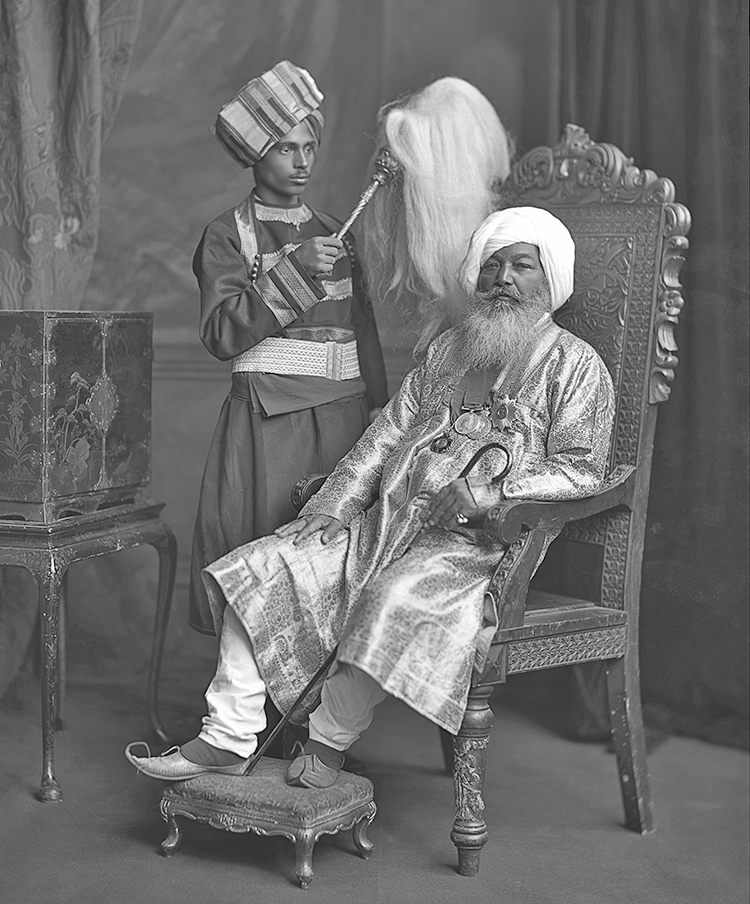
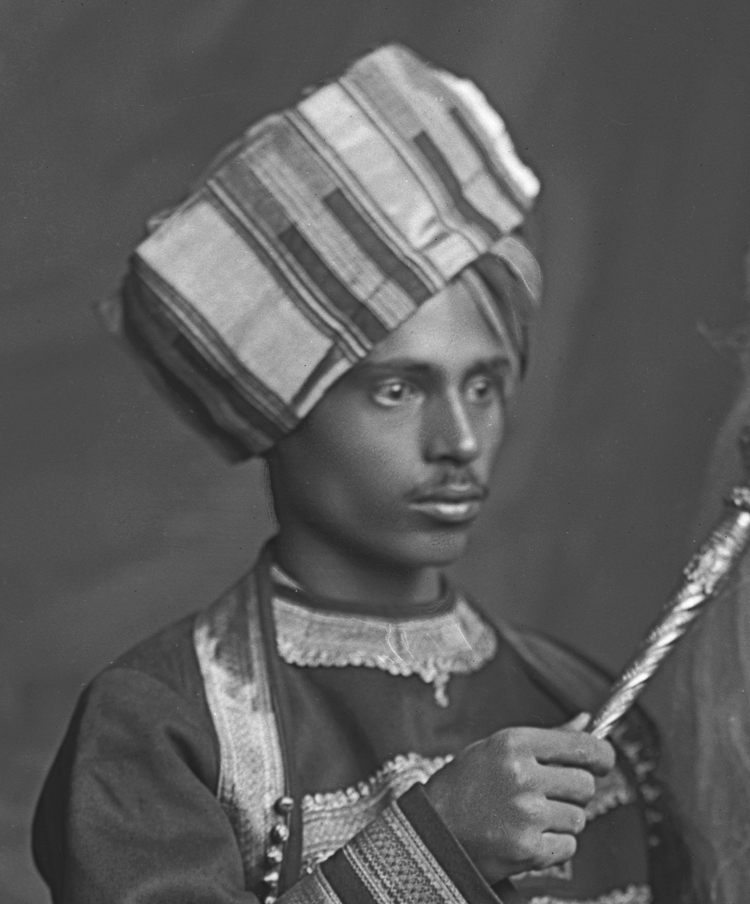
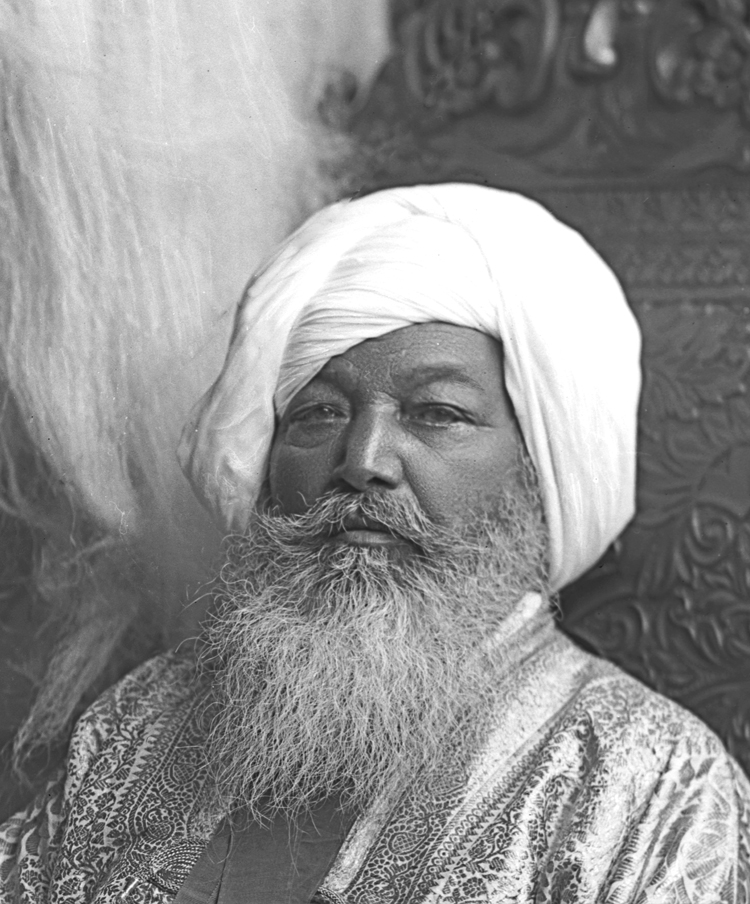
Image published in The Lafayette Studio
and Princely India,
Roli Books, New Delhi
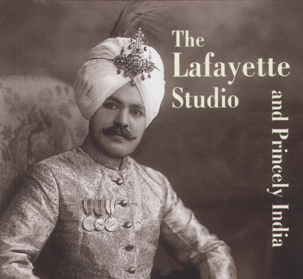
Image published in:
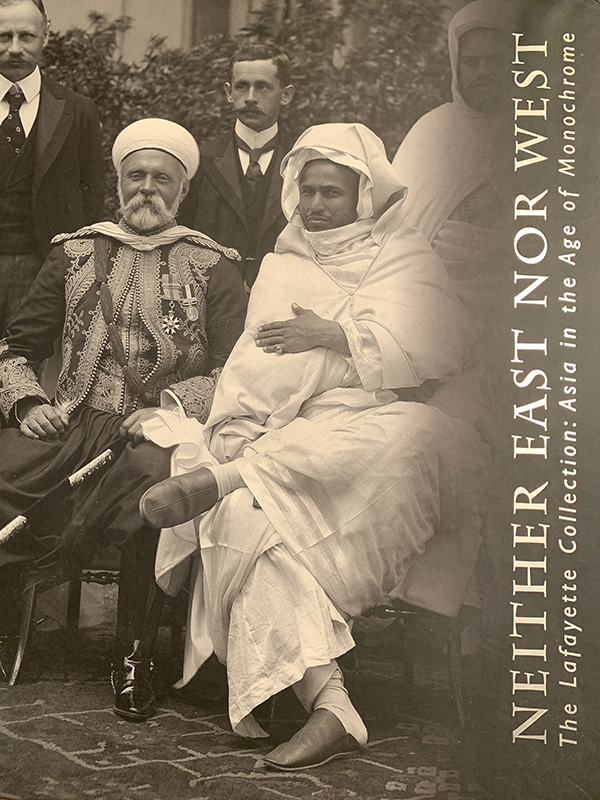
Biog:
14th spiritual head of the Sikh community by direct descent from
Guru Nanak Shah; educator.
Date:
1902.
Occasion:
An official representative of the Punjab at the Coronation of King
Edward VII.
Location:
The Lafayette Studio, 179, New Bond Street, London.
Descr:
FL seated.
Costume:
He wears a splendid choga (robe) of gold brocade probably
woven in Benares and made up in Kashmir or the Punjab in the traditionally
wide-cut choga style. The large boteh or kalka
motifs in the corners of the robe are typical of all sorts of North
Indian textiles, from saris to sashes. Under the choga
he wears plain white cotton paijama and typical North Indian
slippers with curling toes. He sports the untrimmed beard traditionally
worn by Sikhs, and his large turban conceals his uncut hair.
Orders, Decorations
& Medals: Star and Badge of a Knight Commander of 'The
Most Eminent Order of the Indian Empire' [K.C.I.E. cr.
1 January 1898]; Empress of India Medal; Albert Edward, Prince of
Wales, Visit to India Medal 1875-1876.
Furniture &
Props: Jacobean-style photographer's chair with detachable
crest-rail.
Photographer:
Lafayette Ltd., 179 New Bond Street, London. |
| Baba
Khem Singh Bedi one of the founders of the Singh
Sabha movement, was born on 21 February 1832 at Kallar, a
small town in Rawalpindi district, now in Pakistan. He was a direct
descendant, in the thirteenth place, of Guru Nanak. He received
the rites of amrit at the hands of the celebrated Babd Bir Singh
of Naurangabad. His father Baba Attar Singh was killed in a family
feud on 25 November 1839. Khem Singh and his elder brother Sampuran
Singh inherited jagirs in the jalandhar Doab along with 41 villages
in Dipalpur tahsil of of Gugera, later Montgomery (Sahival), district.
On the annexation of the Punjab to the British dominions in 1849,
14 of these villages were resumed by the new government. During
the uprising of 1857, Baba Khem Singh assisted the British in
quelling a local revolt in Gugera district. He personally took
part in a number of skirmishes, proving himself an excellent marksman
with gun and rifle. While accompanying extra Assistant Commissioner
Berkeley on a drive to reopen communications with Multan, Khem
Singh distinguished himself in a cavalry charge on 21 Septernber
1857. The following day he barely escaped death in an ambush in
which Berkeley was killed. The Government of lndia bestowed on
him a khill'at or robe of honour of the value of 1,000 rupees
and a double barrelled rifle. His jagirs were enhanced from time
to time and, towards the end of his life, his possessions in land
in Montgomery district alone amounted to 28,272 acres. He was
appointed a magistrate in 1877 and an honorary munsif in 1878.
He was made Companion of the Indian Empire (C.I.E.) in 1879, was
nominated to the Viceroy's Legislative Council in 1893, and when
the Indian council Act was extended to the Punjab in 1897, he
was among the first non-official members nominated to the Punjab
legislature. He was knighted in 1898 (K.C.I.E).
Baba
Khem Singh was sensitive to the decline that had set in Sikh
society after the occupation of the Punjab by the British and
to the inroads being made by Christian proselytization. The
gravity of the situation was brought home to the community dramatically
when, at the beginning of 1873, four Sikh students of the Amritsar
Mission School proclaimed their intention of renouncing their
faith and embracing Christianity. The Sikhs convened a meeting
at Amritsar on 30 . July 1873, led by Baba Khern Singh Bedi,
Sardar Thakur Singh Sandhavalia and Kanvar Bikrama Singh of
Kapurthala. As a result of the deliberations, a society called
Sri Guru Singh Sabha was established at a largely attended gathering
on the occasion of Dusshehra, 1 October 1873.
Singh
Sabha began to spring tip at other places as well. A co-ordinating
Khalsa Diwan was formed at Amritsar on 12 April 1883, with Baba
Khem Singh as president and Bhai Gurmukh Singh of Lahore as
chief secretary. Serious differences, however, soon arose between
the two. Baba Khem Singh, being a direct descendant of Guru
Nanak, was glorified by his followers which was resented by
man, At the Baisakhi divan at Amritsar in 1884, he was given
the customary cushioned seat in the presence of the Guru Granth
Sahib. The group led by Bhai Gurmukh Singh protested. A schism
arose. Baba Khem Singh's supporters were commonly burlesqued
as Gudaila party. A separate Khalsa Diwan was set up at Lahore
in April 1886. Baba Khem Singh, supported by the Patron of the
Amritsar Diwan, Raja Bikrarn Singh of' Faridkot, secured the
excommunication of Bhai Gurmukh Singh under the seal of the
Golden Temple. This, however, did not help him retain his position
among the Sikh masses; henceforth, his influence was restricted
to the Pothohar region and to some areas in Western Punjab.
There he preached among the Sahajdharis, and brought a large
number into the Sikh fold. Besides the propagation of Sikh faith,
Baba Khem Singh's important contribution lies in the spread
of education among the Sikh masses, especially women. In 1855,
the dispatch of the Court of Directors Of the East India Company,
which initiated a new era in Indian education, was received
at Lahore.
The
following year the Punjab Government established the Department
of' Public Instruction and planned to open 30 single-teacher
primary schools in each district. Baba Khem Singh lent his full
support to the scheme. He also opened schools on his own in
the Rawalpindi division. Out of his immense wealth lie gave
away liberally for this purpose and at least fifty schools for
boys and girls were opened in the Punjab through his help. On
the occasion of the marriage of his daughter in 1893, he donated
Rs 3,00,000 for religious and charitable purposes. Half of this
amount was for setting up a college at Rawalpindi. As a beginning,
a vocational School was opened there, in early 1894, with provision
for training in dyeing, photography, carpentry, tailoring, etc.
Provision was made for subsidized board and lodging for poor
students.
Baba
Khem singh lived in princely style and enjoyed the reverence
of hundreds of thousands of followers in Western Punjab and
what later became the North-West Frontier Province. He was on
a tour of the latter in the spring of 1905 when he suddenly
fell ill. On 8 April 1905, he left Peshawar by rail in a state
of' serious sickness and feebleness, and died at Montgomery
on 10 April 1905. |
| Excerpt from The
Encyclopedia of Sikhism by Harbans Singh. |
| The
Times, 22 May 1905, p 9g
"The death is announced at the age of 73, of BABA SIR
KHEM SINGH BEDI, K.C.I.E., the high priest of the Sikh community
and its representative at the King's Coronation. He was the
14th spiritual head of the Sikhs by direct descent from the
founder of their faith, Guru Nanak Shah. He exercised his great
influence of his community at all times as a loyal and devoted
supporter of the British Government, and he did much to maintain
the martial spirit of his race by encouraging recruits to join
the various Sikh regiments. Some of his own sons wear the King's
uniform, and when he came to England in 1902, as one of the
Punjab representatives at the Coronation, he was accompanied
by a soldier son, a jemadar in the 19th Punjab Infantry. He
had served on the Legislative Councils of both the Viceroy and
the Lieutenant-Governor of the Punjab, and his knighthood of
the Order of the Indian Empire dated back to 1898." |

Evidence
of photographer at work: -
All images
of sitter:
Copyright:
V&A
All
images on this site are copyright V&A. For further information on
using or requesting copies of any images please contact the V&A Picture
Library: [email protected]
including the URL of the relevant page
Provenance: Pinewood
Studios; acquired 1989. 
References:
Biog: Jeevan
Singh Deol, ‘Bedi, Sir Khem Singh (1832-1905)’, Oxford
Dictionary of National Biography, Oxford University Press, 2004The
Times, 22 May 1905, p 9f; The Imperial Gazetteer of India,
Oxford, 1908, Vol XXI, p 271; K. Singh, The History of the Sikhs,
Princetown, 1966 p 217; Dr. Gopal Singh, History of the Sikh People
1469-1978, New Delhi, 1979, pp 615-616.
Date:
Negative sequence.
Occasion:
The Times, especially 20 June 1902 p 5a (arrival) & 14 August
1902, p 8a [ck]; India Office, Refs. L/P&S/7/142/577, L/P&S/3/393/2646.
Costume:
-
Orders,
Decorations & Medals: (K.C.I.E.) Burke's
Peerage; A. R. Litherland, Spink's Catalogue of British Orders,
London 1990 pp 36-7; (Empress of India Medal) ibid.,
p. 145; (Prince of Wales Medal) Andrew Litherland, Spink's;
The Orders and Medals Research Society "The Miscellany of Honours",
No 2, 1980, pp 42-47.
Reproduced:
-

Acknowledgements:
Dr. Isobel Millar, SOAS; (Orders, etc.) A.N. McClenaghan, Editor, Durbar
Magazine; David Bownes; (Costume) Rosemary Crill, Indian Department, V&A.

|